The Conscious Travelers Guide to Israel: A Journey Through the Holy Land
BY JUSTIN FAERMAN & MEGHAN MCDONALD
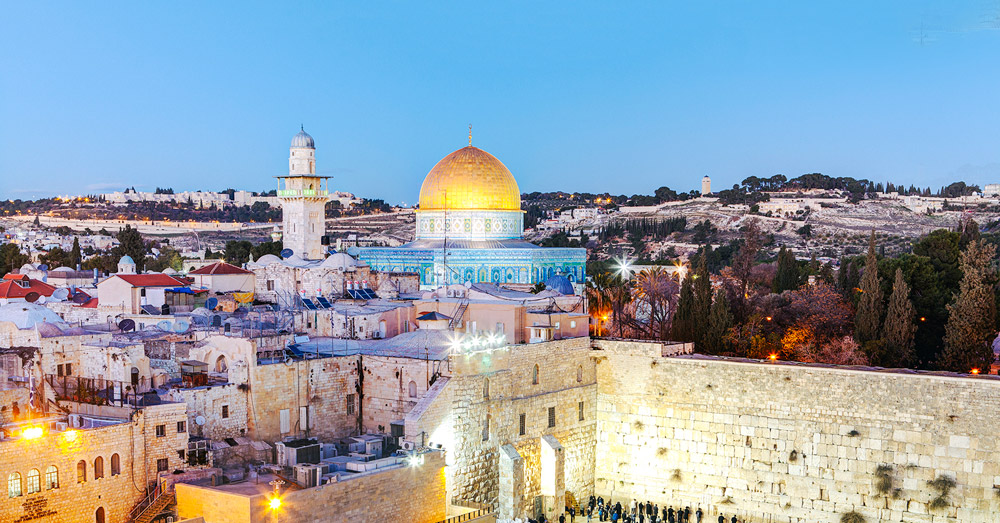 dusk falls on the heart of the old city of jerusalem, just as it has for thousands of years.
dusk falls on the heart of the old city of jerusalem, just as it has for thousands of years.
Editor’s Note: The following article documents a seven-day cultural journey we embarked upon with a group of 50 leaders in the health and wellness space as part of the annual Schusterman Foundation REALITY Wellness trip—an epic journey into the heart of Israel for global changemakers on a mission to repair the world.
It’s unfortunate that the only time most people hear about Israel is when there is some sort of controversy being stirred up by the media. What those stories fail to capture is the incredible beauty, strength and resilience of the people, the rich cultural history pouring from every square inch of the deeply spiritual land and the complexities of daily life in a country caught between extremes of every sort—old and new, conflict and peace, hope and despair, history and future. Looking in from the outside it all seems so simple, but once your feet hit the ground, a different reality unfolds—a juxtaposition of all of the above and beyond that creates a cultural tapestry so intricate and varied it could take a lifetime to fully comprehend.
And we should know, since we traveled in the company of one of the great historians, professors and storytellers of our time, Michael Bauer, who is one of the leading experts in the world on Israel and Middle Eastern geopolitics. Some of his first words to us were that Israel is complex and he himself has more questions than answers.
A Fresh Perspective on The Land of Milk and Honey
With that being said, let us be clear that we are going to tell a different kind of story about Israel—one that you may not have heard. A story that diverges from traditional narratives… not about its past, not about its conflicts, but its bright future as an emerging nation floating in a sea of possibility amongst great uncertainty. Because the Israel we saw was filled with the hopes and dreams of multiple generations for a place to call home, to love, to feel at peace with, no matter what cultural group, religion or identity was being represented. And while yes, there are those who don’t fit that mold and perhaps even want the opposite of that, they are very much in the minority. Like most places on earth, everyone is simply trying to get on with their lives as best they know how.
Tel Aviv
Our journey began in Tel Aviv, the rapidly evolving economic and technological capital of Israel, where you might be forgiven for thinking you had ended up in a middle-sized city somewhere in South Europe was it not for the Hebrew lettering on most of the signs. It’s a fusion of modern international architectural styles with a fair bit of Bauhaus and eclecticism thrown in—just enough to make you never quite sure what to expect around the next corner. This gives the city a sort of mosaic feel—each block slightly different than the next, similar but also distinct, sometimes historic, but mostly modern given how the city didn’t really exist before 1909. That’s with the exception of Jaffa, of course, the ancient Arab port city (which archaeologists date back to nearly 7500 BCE) now neatly incorporated into the southern coastal bosom of Tel Aviv. If you are looking for old world charm, this is where you will find it because the rest of the city seems like it’s racing toward the future with its growing urbanization and development.
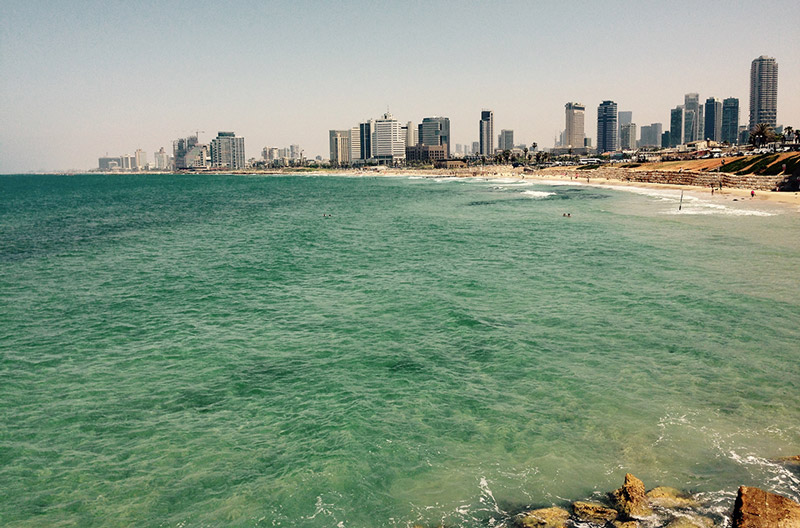 perched on the edge of the crystal blue waters of the Mediterranean sea, tel aviv has a little bit of chill built right in. photo: justen tabert
perched on the edge of the crystal blue waters of the Mediterranean sea, tel aviv has a little bit of chill built right in. photo: justen tabert
These days, Tel Aviv is attracting the country’s best and brightest searching for a future in the startup space, tech, finance, the arts, academia… anything really that is more aligned with the future than the past. While we were there we were treated to an art-infused organic vegan dinner with Avital Sabag, a forward-thinking dietician, chef, teacher, chinese medicine and holistic health expert, in a modern loft somewhere in the heart of the city. The morning after we wandered historic Rothschild Boulevard (where the statehood of the country was declared) and the fruit tree-lined alleyways of ultra-hip Neve Tzedek, the veritable SoHo of the city. Michael led us over to meet Ohad Naharin of the word renowned Batsheva Dance Company and experience his ecstatic dance hybrid movement practice called Gaga at the hands of one of his top students. We were then treated to an impromptu rehearsal of his latest dance production, which was a blend of hip-hop and racy cultural commentary that seemed more appropriate for the streets of Brooklyn than the biblical story land of Israel you hear about in synagogue or church. But, that just goes to show you, that’s a stereotype fostered by outdated cultural narratives and the reality of daily life here is anything but what you’d expect.
The Tel Aviv we saw was a young, modern, culturally rich, first-world city on par with any North American or European capital emerging into the 21st century. It’s no wonder that it has become a sort of under-the-radar mecca for twenty- and thirty-something designers, jet setters, artists, musicians and entrepreneurs over the last few years. It’s sexy, hip, cool and the weather and food are pretty hard to beat.
Galilee & The Golan Heights
After a beachside lunch at the nearby, dazzlingly picturesque Michmoret Beach, we headed north for a long drive to the edge of the Golan Heights, arguably one of the most beautiful areas of the country. The drive there was nothing to sneeze at either, winding through Garden of Eden-esque scenes of rolling, rocky, tree-lined hills in full bloom after recent rains. Michael narrated the drive with fascinating bits of modern and ancient history, helping to unravel the cultural complexities of the land and its peoples. That night we had the pleasure of staying at the Mizpe Hayamim Resort—an organic farm and food wonderland overlooking the tranquil Sea of Galilee of biblical fame. That’s right, the place where Jesus is said to have walked on water and performed countless other miracles. Such is the nature of Israel—modern life coexists right alongside ancient history like few other places on the planet.
Mizpe Hayamim Eco-Resort
Mizpe Hayamim served us up some of the best food we had on the trip—a truly farm-to-table experience, sourced from the grounds of the hotel and the surrounding organic farmland on which it sits. Dinner was a 5-course meal of locally inspired fusion cuisine, and breakfast didn’t disappoint either—some that traveled with us said it was the best they had ever had, all delivered with a distinctly Israeli flair. We are happy to report that the organic food movement in Israel is growing and Mizpe Hayamim is poster child of what’s possible in terms of holistically integrated living, not just in Israel but worldwide.
From the shores of the Galilee we headed northwest to the small village of Peki’in—a rarity in the Middle East. Peki’in is a predominantly Christian Arab and Druze town—two ethnic groups that are very much in the minority in both Israel and other Arab countries on the whole. While cultural integration is still a touchy issue in Israel, the Middle East and, in some sense, the world as a whole, Peki’in is an anomaly in that it is a place where Jews, Arabs and Druze people live in harmony and peace.
The Birthplace of Kabbalah
While there we saw two remarkable things: The first was the birthplace of Kabbalah—an unassuming entrance to a small cave where Rabbi Simeon bar Yochai is said to have divined the Zohar, a foundational text in one of the most profound systems of esoteric spirituality known to man. The second was Grandma Gamila—an inspirational and entrepreneurial Druze woman who built a $50 million per year natural soap empire in the face of overwhelming cultural oppression from humble roots in the village. We spent an hour with her, hearing her story and gleaning gems of life wisdom from an icon of women’s rights and entrepreneurial success.
Tsfat: The Hilltop Town of the Mystics
From there we headed north to the historic hilltop city of Tsfat (also spelled Safed), a hotspot of Jewish mysticism and Kabbalah, where we had a lively group discussion with Evan Yisrael Strauss on the finer points of the nature of reality, consciousness, human psychology and their intersecting path at the heart of Jewish philosophy, Kabbalah and metaphysics on the whole. Our backdrop was The Way Inn, an impeccably designed, biblical-chic sanctuary in the heart of the historic artist’s quarter of the city. Run by the heart-centered but sassy husband and wife duo Gita Zohara and Rony BarEl, think equal parts cozy, bohemian, metaphysical and boutique with some of the best food in the country cooked up in-house with a healthy mediterranean flair. If you are in the area, stopping by is an absolute must, and we couldn’t think of anywhere else we’d rather stay in the city.
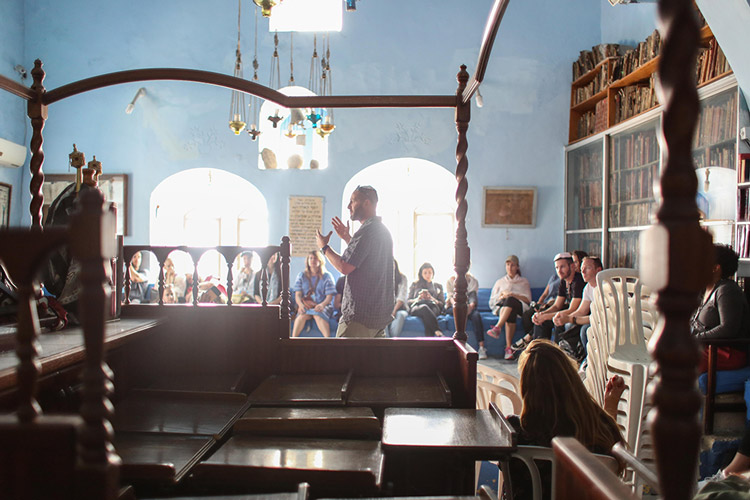 master storyteller and historian michael bauer regals the group with the history of tsfat. photo: sam lucid
master storyteller and historian michael bauer regals the group with the history of tsfat. photo: sam lucid
After a stroll through the quaint but impressive art market, a quick meditation in a secret alleyway near a laughter-filled playground with Expectful founder Mark Krassner and a couple glasses of fresh-squeezed local pomegranate juice, we departed the city for the Syrian border.
Getting Up Close and Personal at the Syrian Border
The Golan Heights, for those of you who don’t know, is a controversial place. At once phenomenally placid and beautiful with lush green fields of rolling grass, wildflowers and farms, it has a war-torn past that can still be felt right up to the modern day. To the northwest it borders Lebanon, and while things have settled down there for the most part, tensions still run high. In the northeast, it borders Syria and, as of this writing, Syria is in the middle of civil and regional war. And when you start to get close to the border, you can tell. Fences and signs warn you of entering seemingly innocuous fields due to unexploded land mines, and gun shots can sometimes be heard in the distance, echoing in from nearby border towns in Syria. We got as close to the border as we could—a bombed-out Soviet-era building only a few hundred meters from the fence. There is not much to see other than a few destroyed villages, but it was, at least for us, more about what the place represents culturally and politically in the region.
Just a few hundred meters further south you might have to pinch yourself to believe an active civil war is going on less than a mile away—there are tracts of residential housing and life seems as beautiful and normal as it does anywhere else, but the future of the area is uncertain. Michael, in typical fashion, artfully explained the delicate complexities of the situation as objectively and philosophically as possible.
It’s a mess, to put it lightly, but there was a story of hope among it all—that Israeli soldiers, in a voluntary showing of humanity and compassion, would freely treat the injured Syrian victims of war left at the border fence by friends and families in modern Israeli hospitals nearby. When strong enough to leave, they returned them to the communities from whence they came, hopefully with a touch of gratitude in their hearts for the selfless care they received that transcended the false boundaries of race and ideology. I couldn’t help but wonder what the solution to a problem of such intensity and complexity was.Mt. Bental
The answer came as we climbed nearby Mt. Bental, perched in stunning panorama of the region—the intention for all involved parties must be harmony, cooperation and peace. For some it is, but for many it is not—it is still about who is right and who is wrong, who controls the power, the money, the politics. Or worse yet, hatred, hurt and retaliation still being harbored for past wounds and losses. The situation reflects the collective consciousness of those involved and, in that sense, thing are headed in the right direction. The region is stable and peaceful now compared to how it has been in the past, but more healing and evolution is needed to get it to where it needs to be. We held this vision for a new future of harmony, cooperation and peace in our hearts and minds during a group meditation before we headed back down toward our destination for the night.
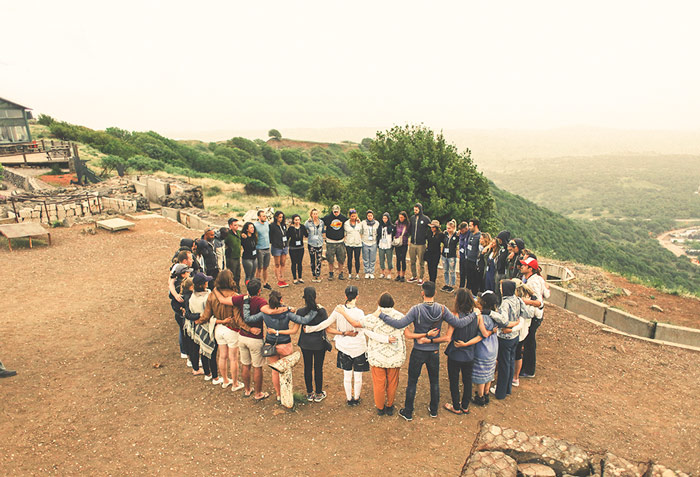 the group meditating for peace and harmony on mt. bental overlooking the border of syria and the expanse of the golan heights. photo: sam lucid
the group meditating for peace and harmony on mt. bental overlooking the border of syria and the expanse of the golan heights. photo: sam lucid
Our last stop in the Golan was the family-run Assaf Winery, where we enjoyed yet another beautiful farm-to-table dinner, created with love from food grown and harvested from surrounding farms. Over a round of their delicious wine, we shared and celebrated the family’s vision of actively owning and operating a family-run wine business in this wild region of the country, bringing normalcy and peace to reshape the land and culture towards a more holistically integrated lifestyle.
Jerusalem
The next morning we set off toward Jerusalem, arguably the spiritual capital of the world, with three of humanity’s five major religions considering it one of, if not the holiest place. And with good reason—the city is hands down the greatest collection of sacred sites and treasures on the planet. You can feel it too. Coming into the city we all were taken aback by thousands of years of collective spiritual intent and prayer we felt radiating from the ethers of the biblical stone walls.
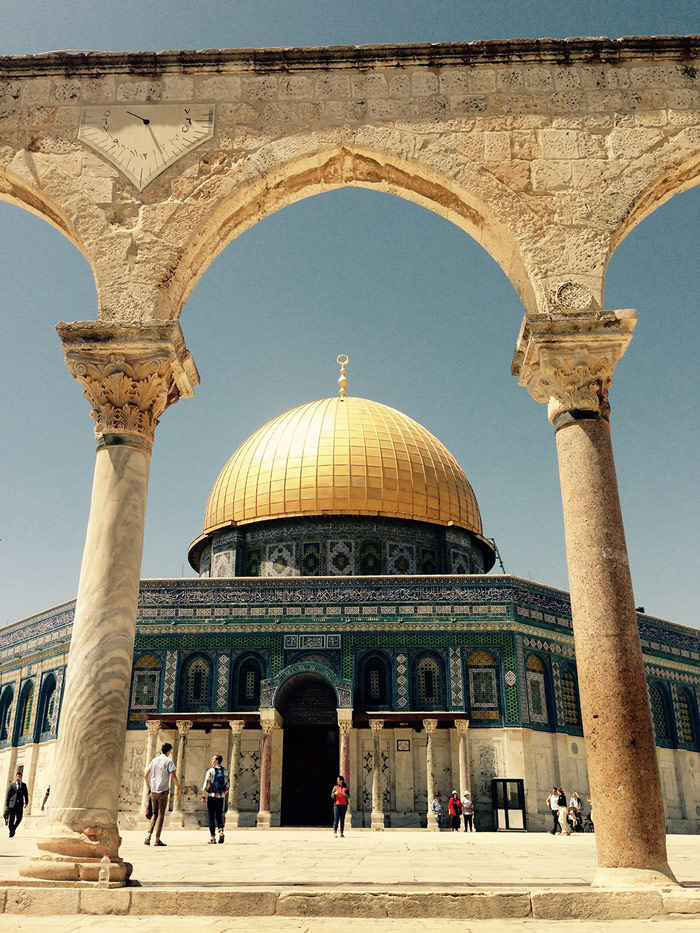 the iconic dome of the rock in the heart of the old city of jerusalem. photo: justen tabert
the iconic dome of the rock in the heart of the old city of jerusalem. photo: justen tabert
I once asked a man who had been to every country on earth what the most interesting place he ever visited was and, without hesitating for a second, he said Jerusalem. And it’s not hard to understand why—there truly is nowhere else like it on the planet. Architecturally, it’s a work of art—a veritable labyrinth of endless limestone alleyways built atop a series of hills that make it impossible to tell where the ground actually is. Like a living M.C. Escher painting, the streets snake upwards, downwards, sideways and diagonally in the old city—where one person’s roof might be another’s walkway. For thousands of years the residents have been building on top of sacred ruins and each other’s houses trying to cram ever more matter into a fixed, architecturally challenging space. The sheer ingenuity of the whole setup is a spectacle in and of itself, with Arabs, Jews, Armenians and Christians all jumbled together in a mish-mash of ever-shifting neighborhoods and streets.
And in the middle of it all you have historical treasures like the Church of the Holy Sepulchre, the Wailing Wall, the Temple Mount, Dome of the Rock and countless other lesser known but extremely important world heritage sites littered like grains of sand across the city. Interwoven into it all are colorful old world markets, modern boutiques and the to and fro of daily life for the hundreds of thousands of people who call the area home.
An Ancient City For Modern Times
Sprawling outward from the epicenter of the old city lie the newer neighborhoods, thankfully still built in the same gorgeous, timeless Jerusalem style, which house everything from residential neighborhoods, to bohemian artists’ colonies to the century-old Machane Yehuda Market, which functions as a farmer’s market selling fruits, cheeses, meats and other fares during the day but at night transforms into a hip, thriving scene that attracts the young and trendy from all corners of the city with its vibrant selection of food and secular bar scene. If you are not from Israel, it’s easy to think of Jerusalem as a “holy land” and forget that nearly a million people call it home and operate much the same way as we all do in the rest of the world. The Machane Yehuda Market might as well be in San Francisco, if it weren’t for all the people speaking Hebrew and Arabic.
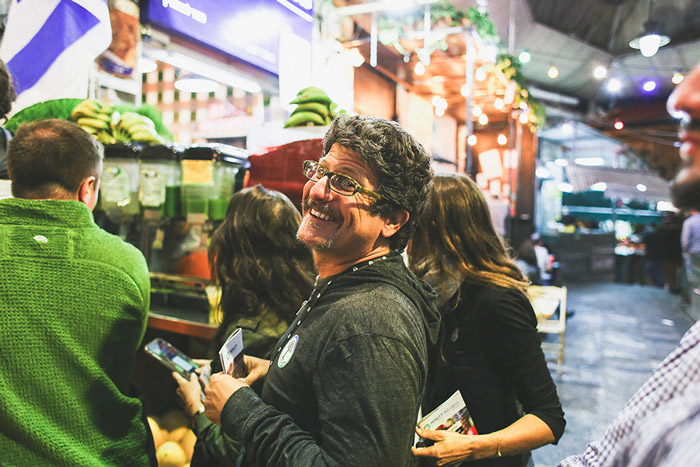 light night adventures in the machane yehuda market with stephen brooks, co-founder of envision festival, punta mona and all around master permaculturist. photo: sam lucid
light night adventures in the machane yehuda market with stephen brooks, co-founder of envision festival, punta mona and all around master permaculturist. photo: sam lucid
We stayed at the famous Mt. Zion Hotel just outside the old city, overlooking the edge of the Palestinian territories, where we were treated to a presentation by the program directors of MEET—an organization that partners with MIT and is working to foster friendship, community and positive social change between Palestinian and Israeli youth through innovative, technology-based programs. Our last night in the city we visited the Western Wall and let ourselves get swept away in the sea of spiritual pilgrims offering ritual prayers and intentions en masse as they have been for thousands of years.
We ended the night with a traditional Shabbat dinner at the Harp of David Art Gallery where we were serenaded by one of the top up-and-coming Israeli musicians Hadas Kleinman and her amazing husband Giora Israel, who embody everything about what is working and progressive in Israeli culture and who are beacons of consciousness and creativity in the region.
Masada and the Dead Sea
No trip to Israel is complete without visiting the Dead Sea—one of the great natural wonders of the world that sparkles from miles away like a sapphire oasis in the otherwise dry and desolate desert environment. The clash of the crystal blue waters against the sterile off-white backdrop of the dusty desert is an extraordinary sight to behold, especially perched high upon the edges of the crumbling cliffs of the infamous Masada fortress. As we toured the mysterious ruins of the centuries-old stronghold under the watchful eye of our faithful guide Michael and the Schusterman team, who were the thoughtful masterminds behind our journey through the sacred land, the blazing midday sun pushed us to the point of no return, and we descended the mountain for a soak in the beckoning sea.
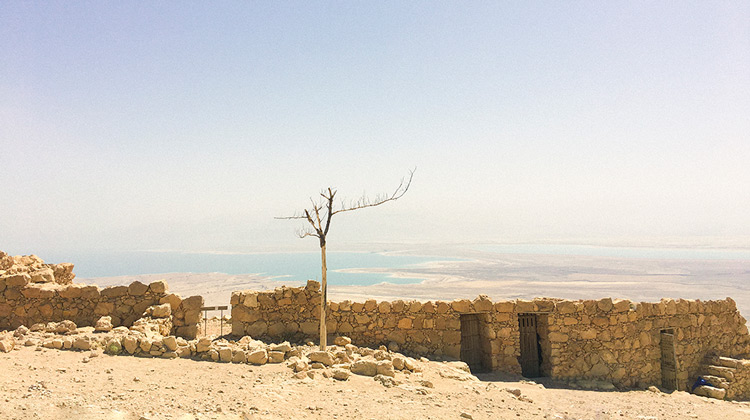 one of the most starkly beautiful places on the planet, mount masada is in many ways the gateway to the dead sea and all that lies beyond. photo: justin faerman
one of the most starkly beautiful places on the planet, mount masada is in many ways the gateway to the dead sea and all that lies beyond. photo: justin faerman
I won’t say much about the experience, lest I ruin some of the surprises this magical body of water has to offer, but suffice it to say that it is quite the sensual experience on every level. From the unusual feel of the hyper-saline waters, to the unique geological formations hiding just below the glassy surface, to the sacred geometry-infused clusters of salt that form on the shores, it’s definitely a once-in-a-lifetime experience that leaves you feeling deeply refreshed and rejuvenated as your body soaks up the highly concentrated trace minerals abundant in the salty sea.
Mitzpe Ramon Crater and the Deserts of the South
After a quick shower, we headed further south into the famous Negev Desert, somewhere between the borders of Egypt and Jordan, making a beeline to the Mitzpe Ramon Crater to catch what turned out to be an epic sunset. Mitzpe Ramon is, in every sense of the term, in the middle of nowhere, where the lines between civilization and nature blur into a hazy palette of orange-hued desert pastels. Spanning nearly 40 kilometers long by 9 kilometers wide and almost a 1000 feet deep, it’s the largest erosion crater in the world—a fact that is not easily forgotten as you stand precariously close to the edge of its vertical cliffs, staring off into the vastness of what seems like the edge of the world.
As our journey edged ever closer to its close, the 50 or so of us who journeyed together that week as part of the Schusterman REALITY Wellness trip came together to name our appreciations and gratitude for the group we traveled with and to seal the container with a shamanic ceremony at the cusp of the crater, the desert wind scattering our intentions for the future of Israel, Palestine its people and the world across the desert lands.
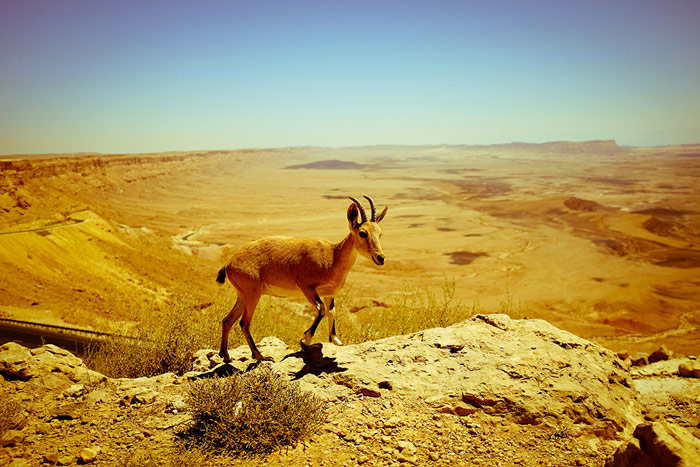 if you are looking to get off the beaten track, head south to the negev desert for a stop at the absolutely massive and surreal mitzpe ramon crater, where you might just see some wild nubian ibixes. they are very friendly, just for the record. photo: amir a
if you are looking to get off the beaten track, head south to the negev desert for a stop at the absolutely massive and surreal mitzpe ramon crater, where you might just see some wild nubian ibixes. they are very friendly, just for the record. photo: amir a
We greeted the wild Nubian ibexes native to the region who wander the area in search of food and made our way back to the impeccably designed Beresheet Hotel perched precariously close to the edge of the cliffs before heading down into the crater itself for a private celebration deep in the heart of the abyss. This was a night that could only be described as a peak experience for everyone involved. We feasted, we danced, we laughed, we cried, we connected at incredibly deep levels and solidified friendships that would last lifetimes.
We emerged from the valley in the early morning for a too-short night of sleep before heading back toward Jerusalem and Tel Aviv for our final goodbyes.
Looking Toward the Future
On the way back toward Tel Aviv from Mitzpe Ramon, you can’t help but pass by David Ben-Gurion’s grave. For all intents and purposes, he is the founder of the state of Israel, which means that, depending on who you ask, he’s either a hero or someone to be hated. Whatever side of the coin you fall on, you can’t deny that he was a visionary and someone who inspired millions of people to do something next to impossible. And when you strip away the politics and endless debate over right and wrong, in many ways the greatest lesson we can learn from him is the power we all individually and collectively have in shaping our future through intention, vision and determination. So much so, in fact, that he decided to spend the later years of his life working to settle the Negev Desert—one of the most harsh and barren (and beautiful) pieces of land on the planet—because of his deep belief that it was an area that could be settled peacefully and without encroaching on the lands of other people already living in the Palestine area when Israeli statehood was formed. As the story goes, he asked to be buried there at Sde Boker and sure enough, his vision lived on as a result—development continues in the area to this day with the formation of a University and the settlements around the Mitzpe Ramon crater.
Shanti House
After the meditative stop at Sde Boker, we made our way to Shanti House, a forward-thinking sanctuary of peace and support created for runaway, homeless and at-risk youth by Mariuma Ben Yosef whose abusive home life left her homeless as a teenager. To date, the two Shanti House locations that she runs in conjunction with her husband have welcomed over 46,000 youth ages 14 to 21, including Muslims, Jews, Christians, gays and lesbians—there is no discrimination, only two rules: no sex, no violence. According to Mariuma, “It doesn’t matters what you believe it matters what you choose.” Some of the youth who end up there live long term and others come for just a few hours, building a much-needed bridge of support between Shanti House and their actual home, knowing they always have a community to turn to in times of need. As we wandered through the grounds, which include a farm, gardens and modern art projects, among many other interesting projects they have birthed, we saw just how much love and intention Mariuma and her husband pour into their work. When it seems like no one else will, they do everything in their power to make sure the young adults who find them are supported mentally and emotionally through various therapeutic modalities, as well as creatively and physically through interaction with art, nature and animals.
Organic Israel
After our visit at Shanti House, we continued onward to the home of Hedai Offaim for one of the most delicious freshly grown, farm-to-table meals of our lives. A pioneer in the sustainable food movement in Israel, Hedai has co-created an innovative, holistic farming system with his brother, Yinon, that allows them to profitably grow organic food using the best of both new and old-world practices. Offaim grows his crops slowly, by hand, without pesticides, preservatives, hormones or genetic engineering, and all his products are sold locally in and around Jerusalem and Tel Aviv.
Hedai’s fruit-tree lined property was the perfect backdrop for our closing ceremony where we collectively reflected on what we had learned, how we had grown and what had been forever altered by our masterfully crafted trip through these magical lands.
The Oasis of Peace
As we headed back toward the airport in Tel Aviv, there was one final stop at Neve Shalom (also called Wahat al-Salam), a forward-thinking, integrative community on the outskirts of Jerusalem where Palestinian Arabs and Jews live together in self-governed harmony and peace—a reflection of what we can only hope is to come for the region and its people. Giora and Hadas, who call Neve Shalom home, once again took the stage to give us insight into how the community operates and the principles behind why it works so well in a region where people often have such a hard time getting along. They bid us farewell with a profoundly deep meditation and musical performance as the reality of returning to our lives back home loomed on the horizon. And as if in a final farewell from the land and her people, a hushed silence fell over the country as a network of sirens blazed in the background commemorating Israel’s independence day so many years ago. It was an auspicious reminder of the past in a town so focused on the future. Such is the nature of this land of paradox that so many desire to call home.
We are forever grateful to Yaniv Rivlin, Seth Cohen, Shir Marom, Cas Feder, Michael Bauer, the Schusterman family and the Schusterman Family Foundation team for facilitating this incredible and deeply transformational journey. Thank you.
About The Authors
Justin Faerman & Meghan McDonald are the co-founders of Conscious Lifestyle Magazine, working to change the world for the better for all people, cultures and identities from the inside out so that we may collectively live in harmony, peace, equality and mutual compassion, cooperation and respect.







